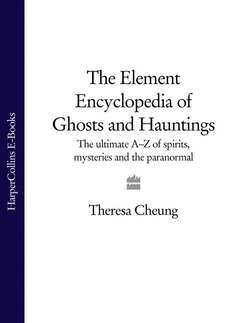Читать книгу The Element Encyclopedia of Ghosts and Hauntings: The Complete A–Z for the Entire Magical World - Theresa Cheung, Theresa Cheung - Страница 148
DAVENPORT BROTHERS
ОглавлениеThe Davenport brothers conducted one of the most popular and successful séance acts of the nineteenth century. Ira Erastas and William Henry Davenport added the spirit cabinet to the medium’s repertoire and their sophisticated performances amazed and mystified audiences all over America and Europe.
Ira Davenport was born in Buffalo, New York on 17 September 1839, and his brother William two years later, on 1 February 1841. Their father, a New York policeman, was interested in stories of rappings reported in nearby Rochester and decided to try a sitting at home with his family. Almost immediately they got results and Mr Davenport would later tell friends that the boys and their younger sister Elizabeth levitated about the room.
The family began to hold regular séances and at one in 1850 the family made contact with their spirit guide, an entity named John King. It was King who allegedly told the family to rent a hall and give public performances, and in 1855, the boys went on stage for the first time, aged 16 and 14. At first their act consisted of table tilting and rapping but soon the Davenport brothers began to introduce new phenomena, such as floating musical instruments playing under their own power and playful spirit hands that touched and pulled at audience members. By the end of the year the brothers had introduced escapes from complicated rope bindings and knots into their séances and, what would eventually become the signature for their act, the spirit cabinet.
The cabinet was a box, similar to a closet, which would be erected on stage. A sceptical member of the audience would be asked to bind and tie the brothers inside the cabinet, making it seemingly impossible for them to escape. However, as soon as the cabinet doors were closed, and the lights turned off, spirit music would play and disembodied hands would appear through apertures that had been left open on the exterior walls.
On occasion, a volunteer from the audience would be placed between the brothers in the cabinet. A few moments after the doors were closed the volunteer would be tossed out of the box with a tambourine on his head. When the doors were opened the Davenports would be found tied up, in exactly the same way they were before.
The act was billed as a séance and created a sensation. Although the brothers never admitted to being mediums – leaving that to the audience to decide – and critics labelled them mere stage magicians, spiritualists hailed their act as genuine proof of spirit phenomena.
In 1864 Southern preacher Jesse Babcock Ferguson joined the brothers to act as master of ceremonies. He travelled with them on their controversial but successful four-year tour of Europe, and claimed to know of no occasion when their phenomena were not genuinely paranormal.
William died suddenly in July 1877 on a trip to Australia and Ira, lost without his brother, retired from performing. During his retirement he was interviewed and befriended by the magician and antispiritualist Harry Houdini. According to Houdini, Ira confessed that the brothers were expert conjurers, not spiritualists, but had got carried away with the public’s enthusiasm for all things supernatural. Ira explained many of the brothers’ escape tricks, such as rubbing their hands with oil so that they could slip out of the ropes more easily, and employing as many as ten hidden accomplices at a time. The most important part of their escapes took place during the binding, when they managed to get plenty of slack into the ropes by twisting, flexing and contorting their limbs. Once they relaxed, the ropes could be easily slipped off.
Despite their natural ability many people remained convinced that they were spirit mediums and that Houdini’s testimony contradicted the signed statements of distinguished believers and reporters. Newspaper accounts, such as the one below, which appeared in the conservative London Post, gave them credit for producing miracles.
The musical instruments, bells, etc., were placed on the table; the Davenport Brothers were then manacled, hands and feet, and securely bound to the chairs by ropes. A chain of communication (though not a circular one) was formed, and the instant the lights were extinguished the musical instruments appeared to be carried about the room. The current of air, which they occasioned in their rapid transit, was felt upon the faces of all present.
The bells were loudly rung; the trumpets made knocks upon the floor, and the tambourine appeared running around the room, jingling with all its might. At the same time sparks were observed as if passing from south to west. Several persons exclaimed that they were touched by the instruments, which on occasion became so demonstrative that one gentleman received a knock on the nasal organ which broke the skin and caused a few drops of blood to flow.
With the media in awe of the brothers and convinced of their powers, it is hardly surprising that spectators were equally amazed and that the Davenports – who were never caught cheating once in their performing career – created a sensation.
